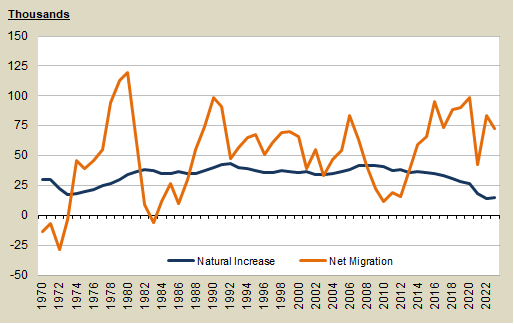Population change: natural increase and net migration
Washington state population
| Year | Natural Increase | Net Migration |
|---|---|---|
| 2024 | 15,280 | 69,270 |
| 2023 | 14,445 | 72,305 |
| 2022 | 13,806 | 83,619 |
| 2021 | 18,122 | 42,543 |
| 2020 | 26,323 | 98,169 |
| 2019 | 28,503 | 89,836 |
| 2018 | 30,974 | 88,432 |
| 2017 | 33,589 | 73,265 |
| 2016 | 35,158 | 95,441 |
| 2015 | 35,631 | 65,780 |
| 2014 | 36,315 | 59,449 |
| 2013 | 36,141 | 38,055 |
| 2012 | 37,903 | 15,869 |
| 2011 | 37,597 | 19,340 |
| 2010 | 40,736 | 11,541 |
| 2009 | 41,722 | 22,307 |
| 2008 | 41,621 | 41,492 |
| 2007 | 41,591 | 63,311 |
| 2006 | 37,888 | 83,534 |
| 2005 | 36,236 | 54,029 |
| 2004 | 34,932 | 46,683 |
1990-2024

- Population change is comprised of two major components -- natural increase and net migration.
- Natural increase (births minus deaths) is the more stable component of population change. Natural increase hit a nadir in 1973
when the number of births in the state fell to its lowest level in the post WWII era, a period commonly referred to as the "Baby Bust." - Beginning in 2006, the children of the baby boomers started reaching childbearing age and the number of births in Washington began to increase. This high level of births, referred to by demographers as the "Third Wave" of the baby boom, was expected to hold for some time. Beginning in 2009, women started having fewer children in response to the recession and the slow pace of the economic recovery.
- In 2024, persons age 65 and over made up approximately 17.9% of the state’s population, up by 5.6% points since 2010. The increase of population aged 65 and older means a smaller share of the population will be women of child bearing age. At the same time, a larger proportion of the state's population will be older and are thus at greater risk of dying.
At the same time, a larger proportion of the state’s population will be older and are thus at greater risk of dying. - Migration into and out of Washington is largely dependent upon the economic conditions within the state relative to the rest of the nation. The Boeing Bust of the late 1960s and early 1970s resulted in probably the greatest exodus of population in Washington history.
- The poor economic climate in California resulted in out-migration of about 400,000 people per year in the early 1990s. Even though Washington's economic growth was slow during that period, it still outpaced California's, thus serving as a magnet to many from the Golden State. More recent economic conditions, though hardly optimal, also favor Washington state relative to California.
Data source:
E-mail: OFM.Forecasting@ofm.wa.gov
Last updated
Friday, January 3, 2025


